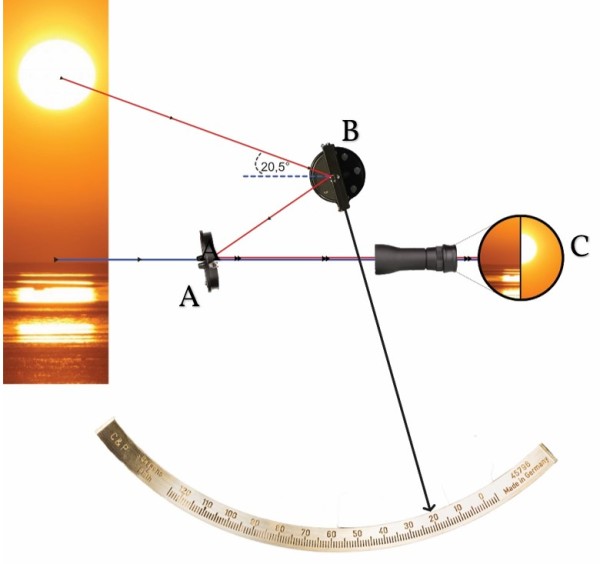Put simply, the sextant is an angle measuring instrument.
The functional principle can be described as follows (see illustration):
The index mirror reflects the light of the star to the inner, mirrored surface of the horizon mirror (A). This in turn reflects the light into the telescope. The observer thus sees the object mirrored twice. As the horizon mirror also transmits the light, the observer also sees the horizon image in direct vision (C).
A distinction is made between the double-mirrored celestial image and the directly seen image of the horizon. The index mirror (B) can be rotated with the alidade.
If the alidade is at the zero value of the arc of degrees, the horizon and index mirror are parallel. The observer sees the same image once directly through the horizon mirror (A) and once doubly reflected via the horizon and index mirrors (A and B). Both images are superimposed exactly if the mirror position is correct.
If both images are shifted vertically, this is referred to as an index error (+ or -), which must be corrected for all measurements. If both images are shifted horizontally in relation to each other, this is a tilt error that must also be corrected. In practice, there is both a horizontal and a vertical shift of the images, which means that both tilt and index errors are involved.
In order to measure the angle between the horizon and the celestial body, the observer moves the alidade until the double-reflected celestial image is aligned with the directly seen horizon image. According to the law of reflection, the rotation of the index mirror corresponds to half the angle between the horizon and the celestial body. For this reason, the arc of degrees on the sextant was engraved in such a way that the reading can be taken directly without conversion. In the illustration, it is 20.5°, which corresponds to the observed hight/angle.
The measuring range of the sextant is 120°, so that the arc of degrees itself only needs to be 60°. This is where the sextant gets its name, as 60° corresponds to the sixth part of the circumference of the circle.
The sextant can also be used to determine horizontal angles for terrestrial navigation (cross bearing) or to determine the length of a side using trigonometry (e.g. to calculate heights of trees).








